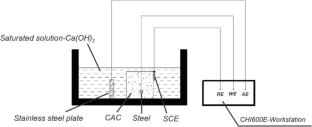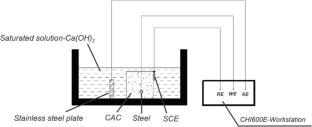海洋混凝土结构钢筋腐蚀多参数定量预测模型研究
摘要
钢筋腐蚀是影响海工混凝土结构耐久性和使用寿命的关键问题。为了建立更准确的钢筋腐蚀速率预测模型,本研究进行了一系列的实验。制备不同钢筋直径和混凝土覆盖厚度的试件,NaCl加入量为0 ~ 0.6%, based on the binder mass, increasing by 0.1%). Two parallel sets of six specimens each (covering different combinations of rebar diameters and cover thicknesses) were made for each NaCl dosage, totaling 84 specimens. The linear polarization resistance (LPR) method was used to test these specimens under the same conditions. The results showed that the relative and absolute corrosion current densities of steel reinforcement in marine concrete generally follow a normal distribution, confirming the reliability of the current research approach. The study also analyzed the effects of free chloride content (\({C}_{\text{f}}\)), cover thickness (C), rebar diameter (D), and exposure time (t) on the corrosion rate. The corrosion current density (\({I}_{\text{corr}}\)) increases with higher free chloride content but decreases with thicker concrete cover, larger rebar diameter, and longer exposure time. Based on these findings, a comprehensive predictive model for the corrosion rate of steel reinforcement in marine concrete structures was developed and validated through significance tests. This model provides a scientific basis for the design and maintenance of marine infrastructure, enhancing the durability of reinforced concrete structures in harsh marine environments.


Corrosion of steel reinforcement is a key issue affecting the durability and service life of marine concrete structures. To develop a more accurate predictive model for the corrosion rate of steel reinforcement, this study conducted a series of experiments. Specimens with different rebar diameters and concrete cover thicknesses were prepared, and NaCl was added in varying amounts (0 to 0.6%, based on the binder mass, increasing by 0.1%). Two parallel sets of six specimens each (covering different combinations of rebar diameters and cover thicknesses) were made for each NaCl dosage, totaling 84 specimens. The linear polarization resistance (LPR) method was used to test these specimens under the same conditions. The results showed that the relative and absolute corrosion current densities of steel reinforcement in marine concrete generally follow a normal distribution, confirming the reliability of the current research approach. The study also analyzed the effects of free chloride content (\({C}_{\text{f}}\)), cover thickness (C), rebar diameter (D), and exposure time (t) on the corrosion rate. The corrosion current density (\({I}_{\text{corr}}\)) increases with higher free chloride content but decreases with thicker concrete cover, larger rebar diameter, and longer exposure time. Based on these findings, a comprehensive predictive model for the corrosion rate of steel reinforcement in marine concrete structures was developed and validated through significance tests. This model provides a scientific basis for the design and maintenance of marine infrastructure, enhancing the durability of reinforced concrete structures in harsh marine environments.

 求助内容:
求助内容: 应助结果提醒方式:
应助结果提醒方式:


